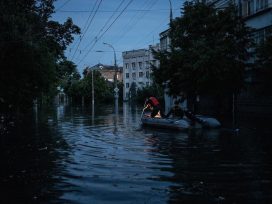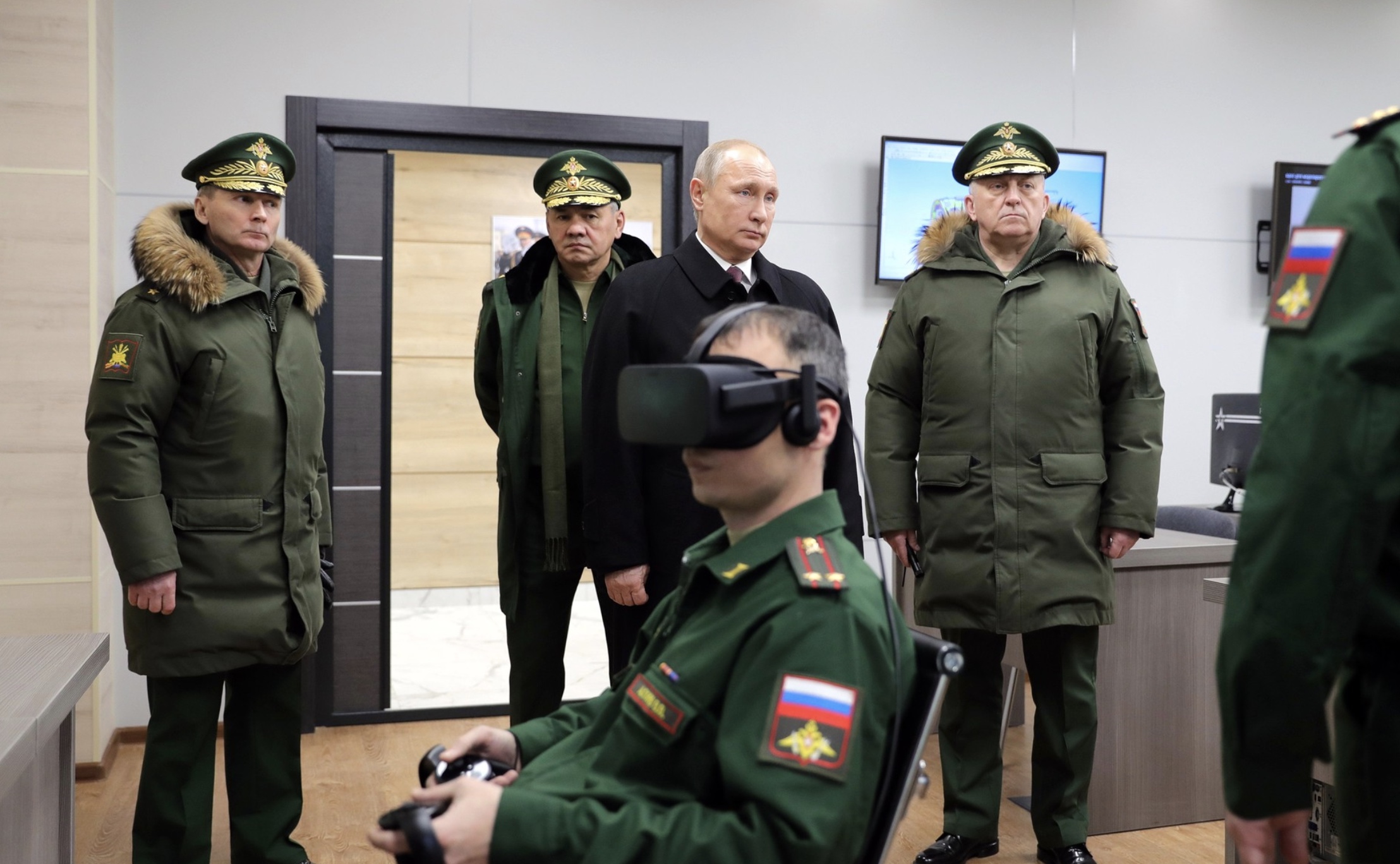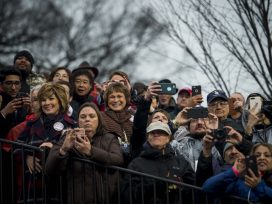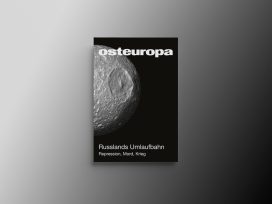Where force is necessary, there it must be applied boldly, decisively and completely. But one must know the limitations of force; one must know when to blend force with a manoeuvre, a blow with an agreement.
Leon Trotsky (1932)
A spectre is haunting Europe, the spectre of ‘hybrid war’. Whether we call it that or one of the other terms sometimes used, from ‘non-linear war’, simply to ‘a new Cold War’ there can be little doubt that at present Russia and the West are locked into a political and normative struggle being fought in familiar and unfamiliar battlefields, from the virtual realms of cyberspace to the minds of people, whether in Topeka, Tallinn, or Tomsk. To the Kremlin, it is responding to a Western – and American-led – campaign to isolate it diplomatically, undermine it politically, and destabilize it culturally, such that Russia is denied its rightful status as a ‘great power’. To the West, it is rather that Moscow has embarked on a neo-imperialist project that challenges both the architecture of the post-1945 global order and the values this is meant to embody.
Putin and his government have concluded that the West began this campaign of gibridnaya voina – hybrid war – not least through, in its eyes, organizing a whole string of regime-changing insurrections, from the ‘colour revolutions’ of the post-Soviet space, through the ‘Arab Spring’ risings and eventually the 2013–14 Euromaidan revolt, which brought down Ukrainian president Yanukovych. The current Russian regime appears not only to have staked its political credibility on its revisionist program, it seems genuinely to believe that this is the only way to preserve Russian sovereignty and cultural integrity. Putin himself speaks increasingly the language of the clash of civilizations between Russia and the West. When justifying the annexation of Crimea, for example, he framed it as a response to a strategic campaign by the West to isolate and control Russia:
We have every reason to assume that the infamous policy of containment,led in the 18th, 19th and 20th centuries, continues today. They are constantly trying to sweep us into a corner because we have an independent position, because we maintain it and because we call things like they are and do not engage in hypocrisy.
In the face of this perceived challenge, and mindful that the West is vastly more powerful according to pretty much any index, Moscow has adopted a strategy that targets the West’s unity and will to act, using a variety of non-military means.
In the West, this is generally described as ‘hybrid war’, a style of warfare that combines the political, economic, social and kinetic in a kind of conflict that recognizes no boundaries between civilian and combatant, covert and overt, war and peace. Rather, achieving victory – however that may be defined – permits and demands whatever means will be successful: the ethics of total war applied even to the smallest skirmish. However, just as Moscow tends to misunderstand or miscast Western ideas and intentions, so too there is a substantial misreading of Russian aims and approaches. One crucial such misunderstanding is to fail to grasp that Moscow envisages two separate kinds of non-linear war, which have become unhelpfully intertwined in Western thinking. The first is the way – as the Russians have been quick to spot – that modern technologies and modern societies mean that a shooting war will likely be preceded by a phase of political destabilization, as in Crimea. The second, though, is the political war that Moscow is waging against the West, in the hope not of preparing the ground for an invasion, but rather of dividing, demoralizing and distracting it enough that it cannot resist as the Kremlin asserts its claims to what it considers its rightful role as a great power, not least including a sphere of influence over most of the post-Soviet states of Eurasia.
The soldiers’ version
The Russians themselves certainly believe the nature of war is changing, and in ways which mean the use of direct force may not always or initially be a central element of the conflict – or even not employed at all. As Chief of the General Staff Valery Gerasimov put it in an article in the Military Industrial Courier in 2013, one that has led people (wrongly) to speak of a ‘Gerasimov Doctrine’:
The role of non-military means of achieving political and strategic goals has grown, and, in many cases, they have exceeded the power of force of weapons in their effectiveness … The focus of applied methods of conflict has altered in the direction of the broad use of political, economic, informational, humanitarian, and other non-military measures – applied in coordination with the protest potential of the population. All this is supplemented by military means of a concealed character, including carrying out actions of informational conflict and the actions of special-operations forces. The open use of forces – often under the guise of peacekeeping and crisis regulation – is resorted to only at a certain stage, primarily for the achievement of final success in the conflict.
However, Gerasimov was not presenting a blueprint for a future without conventional military operations, nor yet hybrid war as originally understood in the West. Instead, he was noting Russia’s conviction that the modern world was seeing more complex and politically-led forms of contestation alongside regular warfare. To this end, Russia’s ‘new way of war’ can be considered simply a recognition of the primacy of the political over the kinetic – and that if one side can disrupt the others’ will and ability to resist, then the actual strength of their military forces becomes much less relevant, even if not necessarily redundant.
When taken in the round, Gerasimov’s article – which was an encapsulation of previous debates more than a novel exegesis– presented ‘hybrid war’ not as an end in itself, but as a stage in a foreign aggression against Russia which could or would lead to chaos and the emergence of fierce armed civil conflict in which foreign countries could intervene. The aim for Russia, he asserted, was to be able to have the kind of forces able to shut out such external intervention and fight and quickly win any conflicts, using massive and precise military force.
Thus, Gerasimov’s vision was in many ways an essentially defensive one for a chaotic modern era, not of an army of covert saboteurs but rather a high readiness force able rapidly to mobilize and focus firepower on direct, conventional threats. In this, he was reprising themes which had emerged in much recent military theoretical literature and presenting a sense of the comprehensive threats facing Russia, threats which required an equally comprehensive answer. After all, as Andrew Monaghan has perceptively observed, facing what appears to be a near-term future of unpredictability and instability, the Russian state has adopted a strategy of mobilization involving ‘what are in effect efforts to move the country on to a permanent war footing’.
Of course, it would be naive to consider today’s Russia as a purely peaceable, defensive power. As events in Georgia and Ukraine have demonstrated, it is aggressive, assertive, willing to use force in support of its geopolitical agenda. Nonetheless, not only the literature but also conversations with Russian military officers and observers underscore the extent to which they truly consider gibridnaya voina to be an essentially Western – American – gambit. As one recent retiree who had served in the General Staff’s Main Operations Directorate put it in a conversation in Moscow in April 2014, ‘we only belatedly came to see the weapon you [Westerners] were developing. Even then, first we thought it just applied in unstable, peripheral countries. Then we saw you could point it at us, too.’
All military doctrines are an evolution of previous ones, and influenced by the technical, political, social and economic forces shaping the battlefield at every level. Today’s Russian approach is broadly rooted in some distinctive characteristics of today’s Russia and past practice, but more specifically is the product of a series of military-political debates and organizational developments that came to fruition following the 2008 Georgian War. The 1979–88 incursion into Afghanistan had forced Soviet military planners to come to grips with asymmetric war, but many of the lessons were deliberately shelved at the time, the result of a foolishly optimistic assumption that Moscow would be embroiled in no more such campaigns. Nonetheless, the experience of that war did creep into subsequent debates in the 1990s, where they combined with a growing awareness of the sheer speed and destructiveness of modern conflict, which would mean that in full-scale war the front line would be deep, and perhaps even ubiquitous, and the potential devastation terrifying.
Nonetheless, the 1990s were taken up by the first war in Chechnya and the challenge of coping in severely constrained budgetary circumstances. Many within the Russian security establishment genuinely understood that the nature of war was changing. However, all such institutions tend towards conservatism, and a combination of self-interested resistance within the high command and a lack of a clear steer from the Kremlin ensured that practice did not move as quickly as the theoretical discussions. Real progress would only follow as a result of the 2008 Georgian War. Russian forces operated alongside local militias and auxiliaries, in a politically choreographed operation designed to provide a degree of deniability and legitimacy by provoking the Georgians into the first overt act of aggression. The Russians won, but that was hardly in doubt given the massive disproportion between the two sides and the relatively limited objectives, ‘liberating’ the already-rebellious regions of Abkhazia and South Ossetia. The point was that they did not win as easily as they had expected. The litany of errors was enough to allow Defence Minister Anatoly Serdyukov and above all his Chief of the General Staff Nikolai Makarov finally to push through sweeping reforms.
Serdyukov’s necessary but brutal modernization program won him the loathing of most of the officer corps. He would not survive long politically; a scandal saw him sacked in 2012, with Makarov following in his wake. However, their successors continued the process, hence the irony of Gerasimov getting the credit for what, if it should be considered any Chief of the General Staff’s brainchild, was closer to Makarov’s. Even so, this was still very much a discussion about war, not the kind of deniable political operations too often regarded as Russia’s new ‘art of war’, more war than hybrid.
Perhaps the best sense of how the Russian military expects a future full-scale war to unfold comes from an article by Colonel Sergei Chekinov and Lt. General Sergei Bogdanov. They depict a war that starts with information and psychological operations and cyberattacks, but quickly moves into a ‘shock and awe’ offensive, starting with massive aerial strikes and moving eventually into a ground combat phase fought with missiles, artillery, tanks, and the final instrument, a man with a gun. This is a far cry from the imagined semi-covert, spooks-and-trolls ‘hybrid wars’ often imagined in the West, which are best considered ‘political wars’.
The politicals’ version
The answer is that although soldiers have been thinking how best to integrate new forms of contestation into their battle plans, so too the ‘politicals’ – national security theorists and practitioners, the security and intelligence community, and the Kremlin – have been exploring their new options. Having learnt his trade as a spy, having built his career on corruption and behind-the-scenes politicking, having forged a presidency through propaganda and hype, Putin also saw the scope for a ‘political war’ rooted in Soviet practices. Thus, the second variation of gibridnaya voina was born.
These political wars, where the end goal is to be achieved by entirely non-military means, are very much how the Kremlin sees its current campaign against the West. Russia has reached back and re-learned a particular Soviet lesson, that political effects are what matters, not the means used to achieve them. Instead of trying to contest NATO where it is strongest, on the battlefield – it is worth remembering that NATO has a combined defence budget of $946 billion to Russia’s $47.4 billion (2.84 trillion roubles) – it is instead an example of asymmetric warfare, using gamesmanship, corruption and disinformation instead of direct force.
After all, here Russia has real strengths. Russia’s intelligence community has enjoyed Putin’s favour, and steadily growing budgets, sharpening their ability to conduct covert political but also terrorist attacks outside Russia’s borders, as well as not just cyberespionage but active cyberattacks. Their networks in the West are now considered generally to be as active, aggressive, and extensive as at the height of the Cold War. The huge government foreign media operation, spearheaded by the RT multi-lingual TV network, has been mobilized in an effort to undermine the will and capacity of the West to resist Russian operations. Meanwhile, the role of Russian money in supporting disruptive and divisive political movements in the West and infiltrating strategic economic sectors remains not just a concern, but one in which European intelligence agencies are seeing growing signs of strategic coordination. In and of themselves, none of these instruments are decisive, but together – and especially if Moscow manages to coordinate them more effectively – they form the basis for a formidable machine for fighting on the political front.
While Moscow has practical reasons and a historical bias encouraging it to adopt this kind of strategy, it also reflects the political nature of Putin’s Russia. When William Nemeth originally posited the notion of hybrid warfare, it was in the context of the Chechen war. His argument was that Chechen society was itself a hybrid, still somewhere between the modern and the premodern, where traditional forms of social organization, notably the family and the clan, could be used to mobilize for war in ways that need not distinguish between ‘regular’ and ‘irregular’ forms of war. Hence, a hybrid society fought a hybrid war.
The ‘hybridity’ of Russian operations likewise reflects a conceptually analogous, even if operationally very different ‘hybridity’ of the Russian state. Through the 1990s and into Putinism it has, however you choose to define it, either failed to institutionalize or actively deinstitutionalized. The result is a patrimonial, hyper-presidential regime characterized by the permeability of boundaries between public and private, domestic and external. Lacking meaningful rule of law or checks and balances, without drawing too heavy-handed a comparison with fascism, Putin’s Russia seems to embody, in its own chaotic and informal way, Mussolini’s dictum ‘tutto nello Stato, niente al di fuori dello Stato, nulla contro lo Stato’: everything inside the State, nothing outside the State, nothing against the State.
As a result, it is not simply that Moscow chooses to ignore those boundaries that we are used to in the West between state and private, military and civilian, legal and illegal. It is that those boundaries are much less meaningful in Russian terms, and additionally straddled by a range of duplicative and even competitive agencies. This can get in the way of coherent policy and create problems of redundancy and even contradictory goals, such as the 2016 hack of US Democratic National Committee servers, where FSB and GRU operations appear to have been working at cross purposes.
However, it also means that it is much easier for the Kremlin to instrumentalize all kinds of other actors, from the Russian Orthodox Church and organized crime to businesspeople. Millionaire Konstantin Malofeev, for example, played a crucial role in the seizure of Crimea and destabilization of the Donbas. Since then, he has been an active agent of Russian influence in the Balkans. Likewise, former Russian Railways head and still close Putin ally Vladimir Yakunin is a vigorous supporter of Moscow’s interests and allies abroad, including supporting Edgar Savisaar’s divisive Centre Party in Estonia.
Of course, it is hard to assess the actual impact and success of all these political ‘active measures’. The desire to undermine Hillary Clinton – whose election the Kremlin appeared to believe inevitable – led to the much less predictable Donald Trump presidency. Attempts to interfere in the 2017 French and Dutch elections backfired. What appears to have been a Russian-sponsored coup to avert Montenegro’s entry into NATO in 2016 failed, and even caused frictions with traditional ally Serbia. Nonetheless, it is safe to say that they have helped exacerbate existing tensions and divisions, galvanize divisive political movements and make the creation of common fronts on questions such as the shooting down of Malaysian Airlines flight 17 over the Donbas that much harder.
Different hybrid defences for different hybrid wars
After the unexpected Russian seizure of the Crimea, especially its use of unacknowledged ‘little green men’ – not, it has to be said, such an innovation in the annals of warfare and statecraft – the notion that something dramatically new and dangerous has taken the West by storm, and led to both insightful analysis and panicked caricatures. For better or (probably) worse, ‘hybrid war’ is for the moment the accepted term of art in Western military and strategic circles. Perhaps, as Latvian scholar Jānis Bērziņš has acidly noted, it has caught on precisely because ‘the word hybrid is catchy, since it may represent a mix of anything’.
The particular concern is often that Russia’s supposed ‘new way of war’ bypasses or neutralizes much of the West’s undoubted capacities and superiorities. But has Russia truly redefined the nature of war through its use of proxies, undeclared armies, and covert political operations in Crimea and the Donbas? Is it really the case that NATO need to worry that, just as having an advantage in horse cavalry mattered little in the age of machine guns and barbed wire, so too as one US officer suggested to me in 2016, ‘we spent billions preparing to fight the wrong war’?
No. Even though each individual aspect of recent operations is familiar, and despite Moscow’s continuing focus on conventional, high-intensity war fighting, nonetheless Russia’s recent actions have highlighted changes in the nature of war that say as much about the evolving global battle space as about specifically Russian military thinking. Thus, the whole debate about hybrid war is really two debates intertwined: about the strategic challenge from an embittered and embattled Russia, and the changing nature of war in the modern age.
From the tsars through the Bolsheviks, the Russians have long been accustomed to a style of warfare that refuses to acknowledge any hard and fast distinctions between overt and covert, kinetic and political, and embraces much more eagerly the irregular and the criminal, the spook and the provocateur, the activist and the fellow-traveller. Sometimes, this has been out of choice or convenience, but often it has been a response to the time-honoured challenge of seeking to play as powerful an imperial role as possible with only limited resources.
When they did, they were also able to draw on an especially rich experience of information operations, in which many have seen the roots of today’s activities. The Soviets were especially concerned with propaganda, misinformation and political manipulation, often with the same goal of masking underlying weaknesses. This tradition also lives on, enriched by the opportunities in the new, diffuse and lightning-speed media age.
Putin was probably speaking for his entire security elite when he said, ‘I think that only someone who has lost their mind or is in a dream could imagine that Russia would one day attack NATO. The threat facing the West is likely ‘political war’, not a hybrid offensive turning into a shooting war. As a result, this is not just a military issue and the challenges of responding to the non-kinetic instruments of this new style of conflict are even more intractable. Should information warfare based on propaganda and spin be counteracted with more propaganda, or with fact-checkers and media awareness classes in schools? For countries with potentially fractious minorities which Moscow could exploit, is the most effective way of buying security to spend more on counter-intelligence officers, police, and social inclusion programs rather than buy tanks or missiles?
Drawing on Russian strategic thinking, though, what implications does this have for present security calculi? If anything, the West should again turn to Gerasimov’s words, this time from a 2014 speech to the Russian Academy of Military Sciences. He called for a ‘comprehensive set of strategic defence measures embracing the entire state apparatus … to convince potential aggressors of the futility of any forms of pressure on the Russian Federation and its allies’. How can the West mobilize to deter or defeat any gibridnye threats, without sacrificing its democratic values and liberties?
Deterrence certainly has its place, and NATO and the European Union alike, as well as national governments, are looking to ways to scale their existing responses also to reflect the smaller-scale initial challenges of hybrid war. However, such measures are best suited to the military form of gibridnaya voina, in which the kinetic is an inevitable, even if later aspect of the struggle. In many ways, the best deterrence against the ‘political war’ form is not so much direct responses – though they undoubtedly have their place – but in creating sufficient societal resistance such that subversion is likely to fail. Whatever else, the Kremlin is pragmatic, and it will not squander political and economic resources on quixotic operations doomed to embarrassing failure. If governance is therefore the new battlespace, then its war fighting forces and measures are thus very different: effective counter-intelligence services, proper oversight over the flow of funds and serious policing of corruption at home, media awareness for a new generation of citizens to render them less susceptible to manipulation from whatever the source, and above all efforts to increase the effectiveness and thus legitimacy of existing political structures.
At a time when, for example, NATO members are being urged to meet a common target of spending 2% of GDP on defence, there is huge variation on European countries’ spending on policing and intelligence. Likewise, the substantial variations in levels of corruption across Europe identified in Transparency International’s Corruption Perceptions Index not only afflicts the citizens of the worst affected countries, it creates vulnerabilities which can then have much wider implications, whether allowing the entry of Russian covert funding (so-called chernaya kassa, ‘black account’ money) which can then be spent on subversion, or simply allowing them to begin to capture local elites and influence the role they play in NATO and the EU.
After all, Russia (and potential future hybrid war antagonists) exploit and rely on weaknesses and vulnerabilities. At present, Moscow is capitalizing on a generalized legitimacy crisis in the West, one which has empowered populists, alienated voters, and catalysed the rise of sensationalist and partisan media voices. Without this crisis, the roots of which are outside the scope of this paper, Putin’s options for political war would be vastly more limited. Perhaps then this is the final lesson, that hybrid aggression of whatever form ultimately stems from weaknesses: a challenger without the strength to turn to direct confrontation, and a defender with sufficient divisions and shortcomings, whether military or socio-political, to be vulnerable. Given the two forms of gibridnaya voina in Russian thinking, the challenge for the West is not to concentrate on one at the expense of the other.








